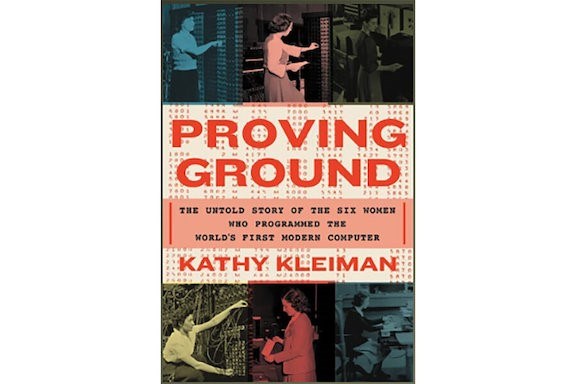REPRINTED WITH PERMISSION FROM THE CHRISTIAN SCIENCE MONITOR
Kathy Kleiman writes a lively tribute to the female mathematicians who calculated ballistics trajectories for the U.S. military during World War II.
 "Proving Ground: The Untold Story of the Six Women Who Programmed the World’s First Modern Computer," by Kathy Kleiman, Grand Central, 320 pp.Christian Science Monitor, with permission
"Proving Ground: The Untold Story of the Six Women Who Programmed the World’s First Modern Computer," by Kathy Kleiman, Grand Central, 320 pp.Christian Science Monitor, with permission
August 10, 2022
The classified ad ran in Philadelphia-area newspapers in the early days of World War II: “Looking for Women Math Majors.” With men enlisting to fight, the U.S. Army’s Ballistic Research Laboratory was hiring women to work at the University of Pennsylvania’s Moore School of Electrical Engineering, to do what had been considered men’s work. They would calculate, by hand, the ballistics trajectories of the artillery being used in battle.
Kathy Kleiman’s “Proving Ground: The Untold Story of the Six Women Who Programmed the World’s First Modern Computer” is a lively group biography of the women who performed those calculations. From there, they were hired to work on ENIAC, the first general-purpose electronic computer, which was developed to speed up the ballistics calculations.
Kleiman has been interested in the group she calls the ENIAC 6 for decades. As an undergraduate studying computer science, she came across an old photograph of ENIAC (short for electronic numerical integrator and computer), the hulking machine in the Moore school’s basement. Two women appeared in the photograph along with four men, but when the author tried to find out who they were, one expert in computer history dismissively told her that they must be models.
Kleiman eventually tracked down and completed oral histories with four of the six women. (The ENIAC 6 are Kay McNulty, Frances Bilas, Betty Snyder, Marlyn Wescoff, Ruth Lichterman, and Jean Jennings.) She founded the ENIAC Programmers Project, which produced a 2014 documentary about them.
ENIAC was created by physicist John Mauchly and electrical engineer J. Presper Eckert. While a missile could reach its target in less than a minute, calculating a missile trajectory by hand took on average 30 hours. Mauchly had long had a vision of an electronic programmable computer, and, with funding from the Army, the war created the opportunity for him to build it, with Eckert’s help. Once programmed, ENIAC could calculate a trajectory in 30 seconds.
Page created on 8/21/2022 8:32:14 PM
Last edited 8/22/2022 1:59:36 PM
